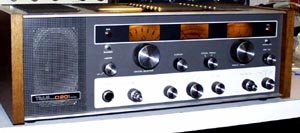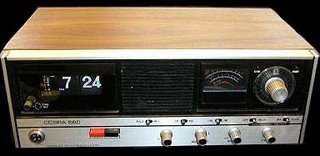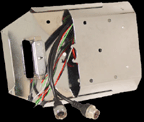"PART II"
[The Times They Were A Changing]
Picking up where I left off... CB was really hot, you had the First Lady, Betty Ford, on covers of CB Magazines (her handle was "First Mama" ), and CB shops were amazing - Many were large sized with a floor model of each radio that you could actually touch! Some even had master switches so you could compare transmission and reception between different models as well as several different base antennas.
-
Of course, prices were high, and if you were lucky, they would knock $10 or $20 off the manufacturers list price, which is what they were selling them for. SSB Base Stations were in the $300-$900 range, and you couldn't snage a mobile sideband rig for less than $300 with the exception of the Midland line.
-
Everyone seemed to follow the "Gentleman's Agreement" regarding channels 16-18 being sideband frequencies so it was a rare occasion when an AM'er tried to use those channels (unlike today). It wasn't just the Gentleman's Agreement regarding AM and SSB frequencies that made things better, it was more like CBer's following their own "Rules of Engagement", which was pretty ironic if you thought about it. The FCC had their set of Rules and Regulations, which for the most part weren't followed by the CBer's (unless "Uncle Charlie" was in town), and then the CBer's had their own "Rules and Regulations" which were, for the most part abided by with: AM "Slang" staying on AM and SSB "Protocols" observed on the sideband channels. Usually when someone new arrived on SSB they'd be 10-4ing ya Gud Buddy etc. and then someone on the frequency would explain to them that: There's no "Good Buddy" talk, no echo mikes, just plain language and your first name and/or a set of numbers, and if they didn't comply, they didn't have anyone to talk to. Usually, if they were approached in a non-combative manner, the newbie to SSB was very eager to learn the ways of the Single-Sideband-Ninja....
-
This seemed to work for a few years, but with more and more people jumping onto the CB bandwagon, the 23 channel spectrum b egan to fill up quickly so crafty Sideband Operators, using VFO's or crystal kits moved to frequencies above channel 23, while AM'ers cut that designated wire to allow them to use channels 22a and 22b (there was nothing more satisfying than hearing the "Clip" noise from the wire cutters....unless of course, it was the wrong wire) I seem to recall on local fellow who got in there with a pair of snips the size of garden shears, and managed to short out everything around the green wire.
egan to fill up quickly so crafty Sideband Operators, using VFO's or crystal kits moved to frequencies above channel 23, while AM'ers cut that designated wire to allow them to use channels 22a and 22b (there was nothing more satisfying than hearing the "Clip" noise from the wire cutters....unless of course, it was the wrong wire) I seem to recall on local fellow who got in there with a pair of snips the size of garden shears, and managed to short out everything around the green wire.
 egan to fill up quickly so crafty Sideband Operators, using VFO's or crystal kits moved to frequencies above channel 23, while AM'ers cut that designated wire to allow them to use channels 22a and 22b (there was nothing more satisfying than hearing the "Clip" noise from the wire cutters....unless of course, it was the wrong wire) I seem to recall on local fellow who got in there with a pair of snips the size of garden shears, and managed to short out everything around the green wire.
egan to fill up quickly so crafty Sideband Operators, using VFO's or crystal kits moved to frequencies above channel 23, while AM'ers cut that designated wire to allow them to use channels 22a and 22b (there was nothing more satisfying than hearing the "Clip" noise from the wire cutters....unless of course, it was the wrong wire) I seem to recall on local fellow who got in there with a pair of snips the size of garden shears, and managed to short out everything around the green wire.-
Many CB sets were located in the kitchen area, sitting against the wall, on the breakfast table - it was a family thing. Mom and Dad had handles and the kids too. Citizens Band Radio manufacturers were k een to this as well and began to make rigs with wood side panels, brushed chrome, and other cosmetics with hopes the base units would make their way into the living rooms of America as well [Note - the wood features also reflected the current fad of wood paneled living rooms, and mobile units with brushed chro
een to this as well and began to make rigs with wood side panels, brushed chrome, and other cosmetics with hopes the base units would make their way into the living rooms of America as well [Note - the wood features also reflected the current fad of wood paneled living rooms, and mobile units with brushed chro me and painted "Wood" accents reflected many vehicles of that era that had fake wood dashboards, or side panels on station wagons].Fanon even had a small base unit with looked like the latest solid-state FM radio tuners of that day. And most manufacturers were keen to the operators love of a BIG Base Station! When the "Joker" invited me down to his house I knew that it was either to show me he new BIGGER Base Station or his new BIGGER antenna. No one wanted to pay six bills or more to get a base that was the size of a small VCR.
me and painted "Wood" accents reflected many vehicles of that era that had fake wood dashboards, or side panels on station wagons].Fanon even had a small base unit with looked like the latest solid-state FM radio tuners of that day. And most manufacturers were keen to the operators love of a BIG Base Station! When the "Joker" invited me down to his house I knew that it was either to show me he new BIGGER Base Station or his new BIGGER antenna. No one wanted to pay six bills or more to get a base that was the size of a small VCR.
 een to this as well and began to make rigs with wood side panels, brushed chrome, and other cosmetics with hopes the base units would make their way into the living rooms of America as well [Note - the wood features also reflected the current fad of wood paneled living rooms, and mobile units with brushed chro
een to this as well and began to make rigs with wood side panels, brushed chrome, and other cosmetics with hopes the base units would make their way into the living rooms of America as well [Note - the wood features also reflected the current fad of wood paneled living rooms, and mobile units with brushed chro me and painted "Wood" accents reflected many vehicles of that era that had fake wood dashboards, or side panels on station wagons].Fanon even had a small base unit with looked like the latest solid-state FM radio tuners of that day. And most manufacturers were keen to the operators love of a BIG Base Station! When the "Joker" invited me down to his house I knew that it was either to show me he new BIGGER Base Station or his new BIGGER antenna. No one wanted to pay six bills or more to get a base that was the size of a small VCR.
me and painted "Wood" accents reflected many vehicles of that era that had fake wood dashboards, or side panels on station wagons].Fanon even had a small base unit with looked like the latest solid-state FM radio tuners of that day. And most manufacturers were keen to the operators love of a BIG Base Station! When the "Joker" invited me down to his house I knew that it was either to show me he new BIGGER Base Station or his new BIGGER antenna. No one wanted to pay six bills or more to get a base that was the size of a small VCR.-
CB Magazines grew in size (both in exterior dimensions and thickness) and everyone wanted in on the latest way to communicate, as well as many "Wannabe" CB magazines appeared and just as quickly disappeared from the magazine shelf rack. Driving down the freeway in the morning, it seemed to the casual observer that every 3 out of 5 cars had some sort of CB Antenna on it. People who otherwise wouldn't know the person in the car 2 lanes away from them, developed friendships, flirtations, and sometimes full blown romances just from their conversations on the way into work. Places like Denny's welcomed CBer's for their weekly "Morning Coffee Break" specials, and I'm sure that more than one employer had several late employees on that special morning where you could "Eyeball" someone and put a face to the "Handle".
-
CB Radio thefts were fairly common - after all, many mobiles cost several hundred dollars (or more), until the no name brands appeared an d offered the buyer a break in price. CB's, being under-the-dash mounted were easy (and fast) to steal, and brought the thief a fast profit on the black market, or local truck stop. CBer's bought devices that would allow the radio to slide into a bracket quickly, and slide out just as fast so they could lock their rig in the trunk. Others had hideaway antenna brackets so they could fold their antenna into the trunk, so their car would not appear to have a CB radio in it [ed.- my memory may be faulty on this one, but I seem to recall watching the local Houston news one night and they had a story about a local guy who invented and put a patent on this device]. If you were monitoring channel 19 while driving down the road it was not uncommon to hear someone offering a CB for half it's value. Once an interested party was snagged, the seller would suggest that they move to another channel to discuss the deal. Not all ON-THE-AIR deals were black market radios, but a good percentage of them were. Today, many thieves consider CB's not worth their time, due to lower prices and the general (yet wrong) impression that CB is dead.
d offered the buyer a break in price. CB's, being under-the-dash mounted were easy (and fast) to steal, and brought the thief a fast profit on the black market, or local truck stop. CBer's bought devices that would allow the radio to slide into a bracket quickly, and slide out just as fast so they could lock their rig in the trunk. Others had hideaway antenna brackets so they could fold their antenna into the trunk, so their car would not appear to have a CB radio in it [ed.- my memory may be faulty on this one, but I seem to recall watching the local Houston news one night and they had a story about a local guy who invented and put a patent on this device]. If you were monitoring channel 19 while driving down the road it was not uncommon to hear someone offering a CB for half it's value. Once an interested party was snagged, the seller would suggest that they move to another channel to discuss the deal. Not all ON-THE-AIR deals were black market radios, but a good percentage of them were. Today, many thieves consider CB's not worth their time, due to lower prices and the general (yet wrong) impression that CB is dead.
 d offered the buyer a break in price. CB's, being under-the-dash mounted were easy (and fast) to steal, and brought the thief a fast profit on the black market, or local truck stop. CBer's bought devices that would allow the radio to slide into a bracket quickly, and slide out just as fast so they could lock their rig in the trunk. Others had hideaway antenna brackets so they could fold their antenna into the trunk, so their car would not appear to have a CB radio in it [ed.- my memory may be faulty on this one, but I seem to recall watching the local Houston news one night and they had a story about a local guy who invented and put a patent on this device]. If you were monitoring channel 19 while driving down the road it was not uncommon to hear someone offering a CB for half it's value. Once an interested party was snagged, the seller would suggest that they move to another channel to discuss the deal. Not all ON-THE-AIR deals were black market radios, but a good percentage of them were. Today, many thieves consider CB's not worth their time, due to lower prices and the general (yet wrong) impression that CB is dead.
d offered the buyer a break in price. CB's, being under-the-dash mounted were easy (and fast) to steal, and brought the thief a fast profit on the black market, or local truck stop. CBer's bought devices that would allow the radio to slide into a bracket quickly, and slide out just as fast so they could lock their rig in the trunk. Others had hideaway antenna brackets so they could fold their antenna into the trunk, so their car would not appear to have a CB radio in it [ed.- my memory may be faulty on this one, but I seem to recall watching the local Houston news one night and they had a story about a local guy who invented and put a patent on this device]. If you were monitoring channel 19 while driving down the road it was not uncommon to hear someone offering a CB for half it's value. Once an interested party was snagged, the seller would suggest that they move to another channel to discuss the deal. Not all ON-THE-AIR deals were black market radios, but a good percentage of them were. Today, many thieves consider CB's not worth their time, due to lower prices and the general (yet wrong) impression that CB is dead.-
So let's look at the picture so far:
- Citizens Band Radio was hotter than a "Pet Rock"
- Thousands of licenses were being processed each month
- While expensive, people found a way to come up with the $$$
- CB Radio Shops seemed to be on every other corner
- And all of these people were crammed into 23 channels
- There were many CB companies competing for your money: E.F. Johnson, PACE, Pearce-Simpson, RCA, Panasonic, Lafayette, Radio Shack, Kraco, Teaberry, Tram, Browning, Cobra, SBE, Courier, Fanon (then Courier/Fanon), Royce, Sears, J.C. Penny, Midland, Hy-Gain, Siltronix, Pal, G.E., Palomar, Utac, Regency, Robyn, Sonar, Gemtronics, Shakespeare, Xtal, and Kris just to name a few, but you get the idea....Citizens Band Radio had more operators than the Amateur Radio Service!!
-
TO BE CONTINUED AT A LATER DATE
-

No comments:
Post a Comment